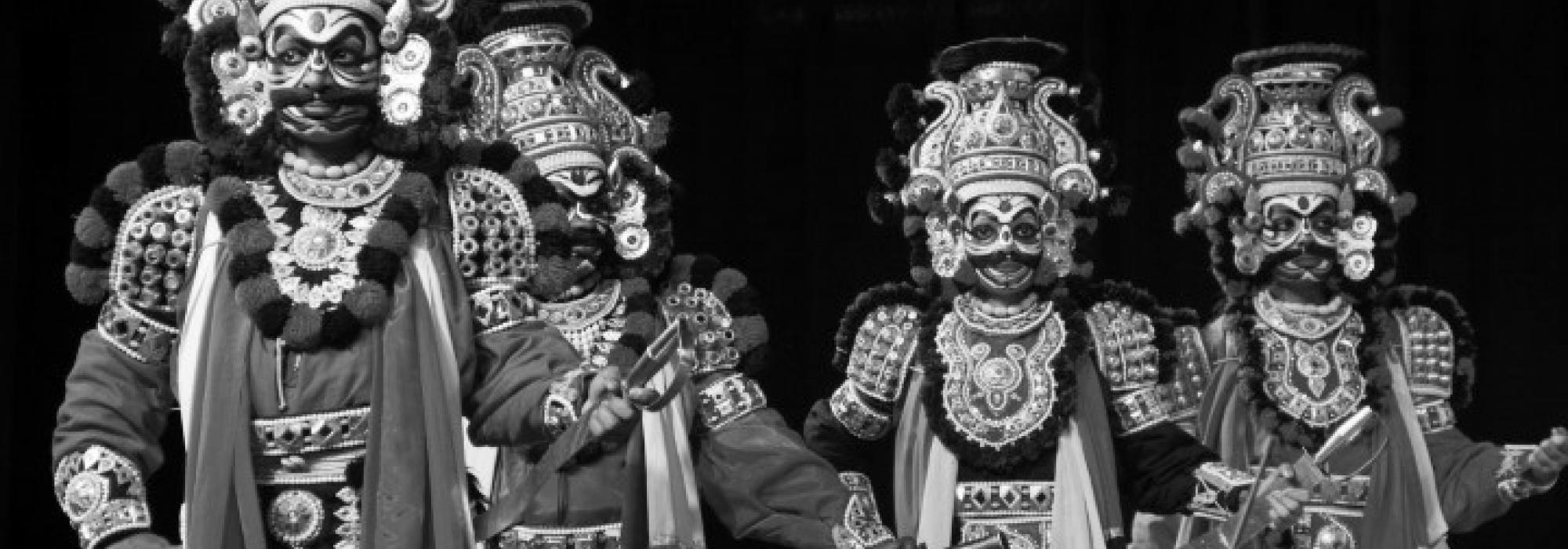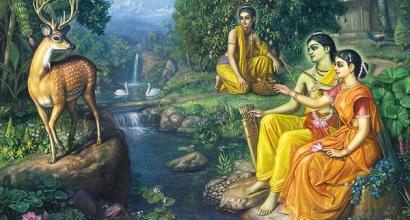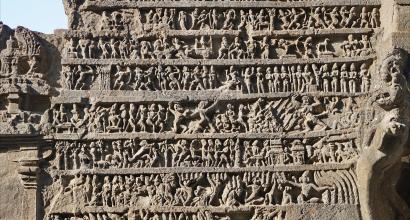For the sustenance and growth of any form of art, novelty and constant practice are essential. They are required both at the level of the individual and the society. Though most people intuitively agree with this, there have been several discussions and debates regarding the nature of the novelty that is introduced in an art and the value that innovation adds to aesthetics. The renowned scholar Sediyapu Krishna Bhat opines that the maturity and profundity of an art dictate the validity, beauty, and aesthetic feasibility of different kinds of changes and innovations brought about in the art. Many forms of art of India (and the world in general), are beautiful both in form and content. The two - ākṛti and āśaya[1] - go hand in hand and are united in purpose; thus, trying to ‘improve’ the art or to attempt changes in haste either in the structure or the content may injure the heart of the specific art. Therefore, all additions, subtractions and modifications must be undertaken making sure that the very nucleus of the art form is not disrupted.
Those who are rigid by nature, conservative in their thoughts and blindly adhere to what they perceive as ‘traditional’, have to keep the above statement in mind. They might have the tendency of protecting even a useless thing as something invaluable. Those who attempt to bring in novelty with great enthusiasm usually fiddle with the form alone, while the conservationists, who are motivated to ‘protect’ the tradition, tend to preserve even the form that might not be beautiful. It is evident that people arguing at these two extremes care little for the essence of art. Thanks to their lack of understanding of the substance of the art, their enthusiastic attempts may not have a positive impact on the art form and might, in fact, lead to distortion. To say it in the language of Indian aesthetics, while trying to alter abhidhā and vakratā to cater to the tastes of different people, the aesthetics of Rasa and dhvani are largely forgotten, ignored or compromised. Therefore, the problem at hand is not that simple to comprehend or to solve.
The inseparability of form and content of an art is not easy for the laity to understand. This is like the inseparability of word from its meaning; it can be understood by direct experience and meticulous analysis alone. Just as the vedāntins say that a person must possess viveka (wisdom) to be able to discern the Brahman from the non-Brahman <>, artistees (and connoisseurs) must understand the framework of aucitya before they go about making changes in any art. Aucitya is an aspect that needs the intellect to work to the maximum extent. It is a function of space and time. The space and time in which an art is created should match with the various features of space and time to which the sahṛdaya (connoisseur) has got accustomed to. The culturing that space and time give to a connoisseur plays an important role in deciding what aucitya is. If the cultured mind of the connoisseur cannot align to the art, then the art cannot be enjoyed, even though it may be excellent in its form. Culture, just like art, has its roots in adhyātma, i.e., philosophy. The fundamental svarūpa of a being is also in adhyātma.
Before attempting to bring about changes and novelty in art, artistees and connoisseurs must first realise the philosophy of the particular art. While the essence of life and world is in Brahman, the essence of art lies in Rasa. Any performance that does not keep Rasa in view will fail. Rasa is a combination of enjoyment and education – the two are unified in spirit and experienced as a whole. Any attempt at presentation, improvisation or change in an art form, where Rasa is lost from perspective will be futile and in extreme cases may also lead to the death of the art form. In Indian art, there is ample scope for the culturing of mind and intellect as well as for sattvodreka (predominance of sattva) – all at the same time. The current essay is a humble attempt at presenting a few points in this background.
~
We can discuss the possibilities of changes in Yakṣagāna under each of the (four kinds of) caturvidhābhinaya, namely āhārya, āṅgika, vācika, and sāttvika. This is because theatre art is a combination of these elements and there is no art beyond these. So let us examine Yakṣagāna from these angles, while keeping in mind the profundity of the art.
Āhārya
The costumes and ornaments worn by artistees along with the stage properties constitute the āhārya. Yakṣagāna is rich in both these aspects. As Yakṣagāna has über-worldly characters and is filled with nāṭya-dharmī, there isn’t much need for any change or improvement in the āhārya of Yakṣagāna. Nevertheless, many scholars have recognised the fact that before Dr. Shivaram Karanth refined the costumes of the Yakṣagāna, its aesthetics was stained due to the influence of the ‘Company Nāṭakas.’<> Further, some of the traditional costumes of Yakṣagāna were also rustic to the point of being crude. The kind of changes brought in by Dr. Shivaram Karanth, Shambu Hedge, Muliya Mahabala Bhat, and Raghavan Nambiar are certainly welcome. That said, the manner in which Karanth has removed some elements of beauty from certain costumes proved to be detrimental to the aesthetics. His main contribution lies in aligning the design of the costume of the strī-veṣa with the finesse, beauty and exuberance of the puruṣa-veṣa. This is certainly laudable. The efforts put by Udyavara Madhavacharya are also noteworthy.[2]
The kind of improvisations made by Mantap Prabhakar Upadhya are welcome and important. He adopted a ready-made costume that resembles a kaccè -sari and a headgear that resembles kedagè-mundalè of the puṇḍu-veṣa. He applies alatigè (a red dye; called ‘ālaktaka’ in Sanskrit) on his fingers and feet to ensure that hastābhinaya (hand gestures) and the movement of the feet are more pronounced. This addition has made the strī-veṣa of Yakṣagāna more graceful.
The work done by PātāLa Venkataramana Bhat in refining the strī-veṣa is remarkable as well. He designed vartula-śirobhūṣaṇa (circular headgear), bhujakīrti (shoulder ornament) made of haraḻu-maṇi (beads and semi-precious stones), and the padaka on the chest – for Tèṅkutiṭṭu Yakṣagāna. These resemble the ones used by Mantapa Prabhakara Upadhyaya. In addition to this, he introduced the kaccè sari to the Tèṅkutiṭṭu costume. He even welcomed the stitched costume that was designed and used by Mantap. Strī-veṣa now uses a kaccè-sari and this is a fact worth noting and is a great value addition. In my opinion, rather than actually tying a long sari into a kaccè, it would be better to have a stitched one that resembles the kaccè in its form. The stitched one will serve the aesthetic purpose and will also enable the artiste to perform nṛtta more effectively. It adds beauty to the limbs and helps give the movements a pronounced effect. However well an artiste might wear the real kaccè sari, it invariably gets pulled up as he performs footwork and variants of nṛtta on the stage, revealing his shanks. This is an unwarranted distraction on most occasions and must be avoided. Such inadvertent mishap with the clothes also causes aesthetic rupture, thereby discomforting the spectators. To avoid such circumstances, some artistees wear a pyjama below the kaccè-sari to avoid any embarrassment. However, if the underlying pyjama gets inadvertently revealed, it causes a greater aesthetic rupture and moreover, the revealed pyjama doesn’t go well with the rest of the costume. Many people feel that if they start using stitched costumes, Yakṣagāna will ‘become Bharatanāṭyam.’ Perhaps they forget that that the stitched costume used in Bharatanāṭyam is markedly different from that of Yakṣagāna.
To be continued...
This series of articles is authored by Shatavadhani Dr. R Ganesh and have been rendered into English with additional material and footnotes by Arjun Bharadwaj. The article first appeared in the anthology Prekṣaṇīyaṃ, published by the Prekshaa Pratishtana in Feburary 2020.
[1] Structure and Substance respectively; also the form and content, respectively – is also referred to as rūpa and svarūpa
[2] However, the kamala-mundalè he introduced, especially for the kirīṭa-veṣa, stands out for its oddity and is rather inappropriate for the art.
















































